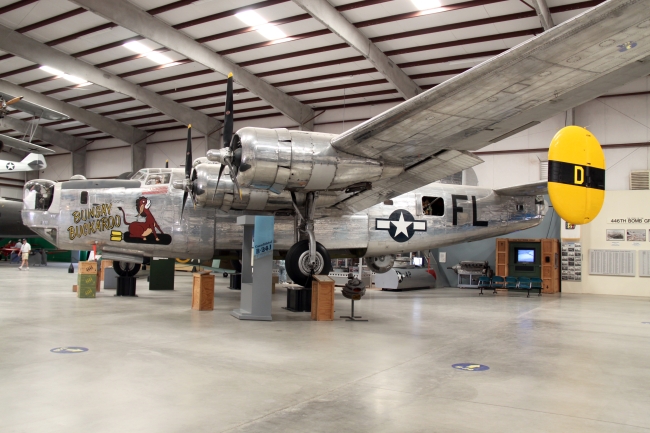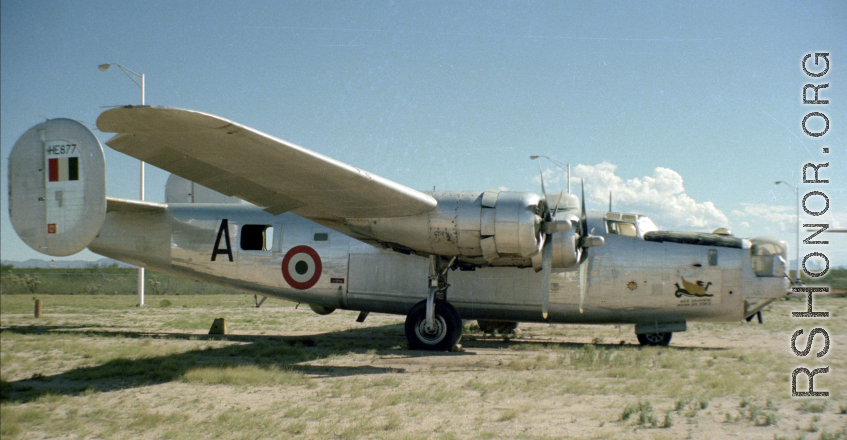B-24 #44-44175, (formerly RAF KH304, IAF HE877), in a field at Pima, Arizona, in September 1974. (Image courtesy eLaRef with much appreciation.)
Return B-24 From India in 1969 (AMOCO TORCH; Author unknown, but Mr. Weber had a carefully copied version among the materials he shared with Remembering Shared Honor, and we pass it along here.)
It was near midnight, March 4, 1945. The B-24 bombers had just wheeled in from the Gulf of Siam and were threading their way single file up the Chao Phraya River toward their target, Bangkok.
Spaced 10 minutes apart, each of the 18 planes would make its run to bomb the docks used by the Japanese to supply their Burma-India campaign.
Lt. Virgil "Tex" Poston was in command of a bomber well back in the formation. Earlier that afternoon he'd flown the B-24 -- named the “Cactus Kid” by the crew--from the steamy runway of his base at Pandaveswar, India.
Before this mission would end, Poston would log more than 18 hours at the controls, flying nearly the distance from New York to Los Angeles. Because they were operating at maximum range for the B-24, over some of the world's most forbidding jungles and waters, there could be no margin for error.
As Poston eased the four-engine plane into the bomb run, Thurzal Terry, the bombardier, had the best view of the approaching target from his "greenhouse in the plane's nose. Dozens of searchlights probed the blackness. He could see muzzle flashes of the guns in the dock area, then the shells as they left the gun barrels, rising in glowing arcs toward the planes running the gauntlet ahead.
They were only moments from the target when the searchlights locked onto Cactus Kid, flooding the plane's interior with dazzling light. Committed to the bomb run, Poston had to hold his plane straight and level, despite the lights and the lethal fireworks that flashed and exploded nearby.
The Japanese gunners, with the plane trapped in their web of lights, soon found the range. A 20mm shell slammed into the vacant nose gunner's turret over Terry's head. Another projectile ripped through the right wing between the two engines, inches from the engine oil reservoir tank and the wing's main spar. That 40mm shell failed to explode. The plane shuddered as more shells exploded, rattling the fuselage with shrapnel.
Hunched over his bombsight, Terry could see thickening streams of fiery tracers converging on the bomber. The lights and gunfire made it all but impossible to concentrate on his target.
"Tex, let's get the hell out of here!" he called over the intercom.

"We can't," Poston replied, struggling to control the lumbering bomber in the turbulence created by the bursting shells. "We have the camera on board, and we've got to get the damage pictures."
What concerned Terry more than his personal safety was the realization that this mission demanded the ultimate in precision bombing. He and Poston knew that immediately to the left of their assigned target, the Japanese had established a prisoner-of-war camp. They also knew that some of those prisoners were downed American airmen who had been captive for more than three years.
Terry did make those final, critical adjustments to his bombsight. But he would never forget the "awful anxiety" of that moment when he released 4,500 pounds of high explosive and incendiaries into the night sky over Bangkok.
Today, 33 years later, Poston and Terry still have vivid memories of that mission. Poston is an area foreman in Amoco Production Company's Houston Division, assigned to the Tyler, Tex., office. Terry is president of his own construction company in Tarzana, Calif.
One other person was present--a construction company president from California. Museum personnel, searching old military records for B-24 crewmen who had served in India, had randomly selected the name of Thurzal Terry, and invited him to attend the welcoming ceremony.
As the aging warplane taxied to the apron, the crackle of her engines and less than graceful lines contrasted sharply with the swept-wing, jet-age sleekness around her.
When the speeches were made and the crowd thinned, Terry walked over to the aircraft. Under the left wing he noted the oil streak that had been thrown by the inboard engine. You would think, he mused, that after a quarter-century someone would have corrected that problem.
He walked slowly around the plane, carefully examining it, pausing near the bombardier's station he knew so well. Could this be the Cactus Kid? he wondered. He had long suspected she lay rotting on some forgotten jungle airstrip.
Turning toward the officers club to join the reception for the flight crew, Terry glanced back once more at the old bomber. He remembered the painting on the left side of the nose--a bowlegged cowboy, complete with woolly chaps, 10-gallon hat, and lariat. Now there was a winged gargoyle and other Indian markings.
Terry couldn't be sure, of course. But this old warhorse almost seemed as if it wanted to tell him that she was the Cactus Kid, formerly of the 9th Bombardment Squadron, United States Army Air Corps, Pandaveswar, India.
It was good this old plane had survived. It was good she had finally come home.
"I don't know how he did it," Terry recalled recently, "but Virgil -- of course, we called him "Tex" in those days -- held that plane right on course and our mission was a success. He was a fine pilot, really top-notch, and his flying was responsible for any success I had as a bombardier."
Terry, who kept an informal diary that included details of each mission, explained that World War II bombing depended as much on the ability of the pilot as it did on the bombardier.
"He had to hold the plane within two or three knots of airspeed and 10 or 20 feet of altitude," Terry said. "That was a challenge in the B-24 under the best of conditions, and you can imagine what it was like under fire. Virgil had that ability."
Until recently, Poston hasn't thought much about that raid or the 60 others he flew during the war. But the memories stirred again last July 15 at Wright-Patterson Air Force Base in Ohio, when Poston and his crew members were reunited for the first time since 1945.
"We'd talked about getting together for years," Poston said, "but the reunion really got started with a card we received last Christmas from one of the crew. My wife Betty wondered if he was in contact with any of the other crewmen, so we started checking."
Within a few months all of the crewmen were found except for the radio operator. Betty enlisted the aid of Terry Clinton, wife of Amoco electrician James Clinton. Terry, a Tyler police department employee, arranged for the police chief to contact St. Louis police who found the missing crewman in that city.
But there is one other survivor of duty in India -- one of the B-24s who had carried those young men home safely from missions over Bangkok, Rangoon, and the China "Hump."
When the war ended and American airmen came home, their B-24s were taken over by the Indian Air Force. Over the next 24 years, they served as coastal patrol bombers, logging a nearly incredible 200-300 hours each month. When one of the planes was retired in 1969, India offered her to any U.S. museum that would pay the cost of returning her to the states. A request by the Pima County Air Museum in Tucson was approved.
When word of the offer spread, Pan American Airways and TWA pledged maintenance and communications support and Shell Oil provided fuel and lubes. The U.S. Air Force supplied a crew who, after four days of training by the Indian Air Force, began the 31-day, 12-stop journey home from halfway around the world.
That odyssey was an adventure from the start. Shortly after takeoff, the plane's radio went out as the five-man crew neared Karachi, Pakistan, across the then-troubled border from India. Moments later a flight of Pakistani jet fighters swept up to intercept them, and escorted the B-24 to an unscheduled landing at Karachi.
When explanations were made, the crew was permitted to resume the flight a few days later.
Other, less serious, problems included balky cabin heaters and batteries that began spewing their own acid--B-24 idiosyncrasies familiar to former crewmen. On the long over-water leg from the Azores to St. John's, Newfoundland, two engines failed during fuel-transfer operations, but were successfully restarted.
On April 27, 1969, a group of dignitaries that included Gen. Jimmy Doolittle and representatives of the U.S. and Indian governments, watched as the B-24 made its final landing at Tucson's Davis-Monthan Air Force Base.
